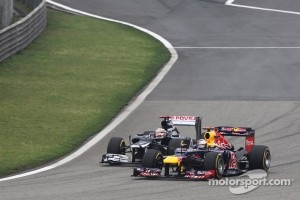
Photo by: XPB Images
9 May 2012 — Three weeks after scoring a 1-2-3-4 finish in the Bahrain Grand Prix, its first clean sweep of the top four since 1997, Renault Sport F1 heads to Spain and the Circuit de Catalunya for round five of the 2012 championship.
The 4.655km circuit outside Barcelona is a medium downforce, middle of the road track for engines. Nevertheless there are some careful preparations specifically required for the RS27 V8 for the Spanish Grand Prix.
Spanish Grand Prix facts and figures
The 1km pit straight, where the cars reach over 300kph and maximum rev limit, gives a possibility for a double KERS release as the KERS energy counter resets, which should increase overtaking possibilities. There are several good opportunities for the KERS to be recharged over the course of one lap, including turns 1, 4 and 10.
Wind direction can often change at Barcelona due to its proximity to the sea and mountains. This can make gear ratio selection difficult down the long straight, particularly as there are a couple of bumps down the pit straight, which can cause the engine to hit the limiter.
The track follows the contours of the hills, and therefore undulates over the course of the lap. The up-and-down nature of the track and the length of the corners mean the cars will be subject to high lateral forces. To maximise acceleration without compromising on power, Renault Sport F1 engineers create engine maps that can be used with short gear shifts.
The second sector is more flowing than sector one, but it is nevertheless hard on the tyres due to the long corners and the fact that the drivers run onto the kerbs through this section. Different overrun settings can be used to stabilise the rear under braking, but this can increase fuel consumption.
The long turn 3 is a challenge for the drivers. In qualifying it can be taken almost flat, but in race trim the driver may short shift before the apex to make it easier to control the delivery of torque through the corner, thus preserving tyre life. With up to four stops expected in Barcelona, this could be a vital advantage in gaining track position.
The drivers’ view:
Pastor Maldonado, Williams F1 Team
We know Barcelona very well from winter testing; in fact Williams-Renault covered the most kilometres of any team there this year. It is a medium downforce, medium speed track but the changing altitude over the lap plus the length of the corners make it quite a physical race. The first corner is quite representative of this; we accelerate through the mid corner to the exit into the second and third turns, so it forms one long corner. Lateral g-forces are quite high but the corner also goes uphill, so we need the engine to deliver a smooth torque curve but also short shift pattern to give controlled power to counter the high g. Through the final sector, which features the new chicane, we need effective engine braking but also responsiveness as we brake down to round 60kph before accelerating hard onto the long pit straight.
The engineers’ view:
Head of Renault Sport F1 track operations Rémi Taffin gives his thoughts on Barcelona:
We covered more than 10,000km over our four teams in winter testing at Barcelona, so we know this track like the back of our hand. It is around 60% full throttle with a variety of low and medium speed corners, so it makes a very good ‘average’ of characteristics of the other circuits on the calendar, and therefore very good for testing purposes.
With 60% of the track taken at full throttle, we need to deliver response and drive through all the ranges, but particularly the lower end for the medium and slow speed sections in sector three.
We expect to be running higher mileage on Friday as our partners introduce new mechanical and aero parts for the first race of the European season, so we will be fitting engines previously used in race conditions for free practice to not put extra mileage on the race units. The extra test session held at Mugello last week means we got a head start on understanding some of the developments so we can concentrate on optimising all the systems.
After the result in Bahrain of course we are all motivated to keep this momentum going. We also have a target to keep our results up in Spain. Red Bull has won both the last races and over the past 10 Spanish GPs, a Renault engine has finished on the podium seven times so there’s a record to keep!
Be part of Motorsport community
Join the conversationShare Or Save This Story
Subscribe and access Motorsport.com with your ad-blocker.
From Formula 1 to MotoGP we report straight from the paddock because we love our sport, just like you. In order to keep delivering our expert journalism, our website uses advertising. Still, we want to give you the opportunity to enjoy an ad-free and tracker-free website and to continue using your adblocker.




















Top Comments